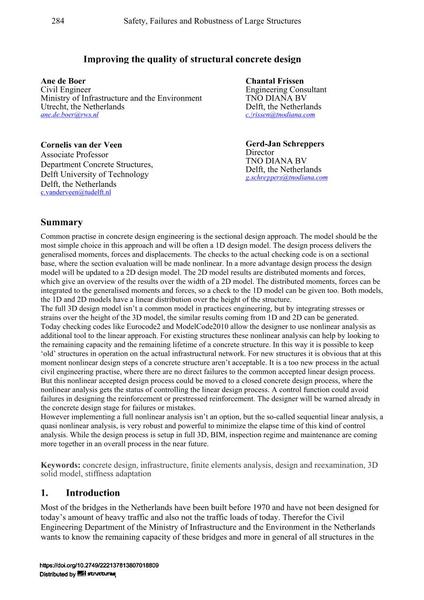Improving the Quality of Structural Concrete Design

|
|
|||||||||||
Détails bibliographiques
| Auteur(s): |
Ane de Boer
Chantal Frissen Cornelis van der Veen Gerd-Jan Schreppers |
||||
|---|---|---|---|---|---|
| Médium: | papier de conférence | ||||
| Langue(s): | anglais | ||||
| Conférence: | IABSE Workshop: Safety, Failures and Robustness of Large Structures, Helsinki, Finland, 14-15 February 2013 | ||||
| Publié dans: | IABSE Workshop, 14-15 February 2013, Helsinki | ||||
|
|||||
| Page(s): | 284-291 | ||||
| Nombre total de pages (du PDF): | 8 | ||||
| Année: | 2013 | ||||
| DOI: | 10.2749/222137813807018809 | ||||
| Abstrait: |
Common practise in concrete design engineering is the sectional design approach. The model should be the most simple choice in this approach and will be often a 1D design model. The design process delivers the generalised moments, forces and displacements. The checks to the actual checking code is on a sectional base, where the section evaluation will be made nonlinear. In a more advantage design process the design model will be updated to a 2D design model. The 2D model results are distributed moments and forces, which give an overview of the results over the width of a 2D model. The distributed moments, forces can be integrated to the generalised moments and forces, so a check to the 1D model can be given too. Both models, the 1D and 2D models have a linear distribution over the height of the structure. The full 3D design model isn’t a common model in practices engineering, but by integrating stresses or strains over the height of the 3D model, the similar results coming from 1D and 2D can be generated. Today checking codes like Eurocode2 and ModelCode2010 allow the designer to use nonlinear analysis as additional tool to the linear approach. For existing structures these nonlinear analysis can help by looking to the remaining capacity and the remaining lifetime of a concrete structure. In this way it is possible to keep ‘old’ structures in operation on the actual infrastructural network. For new structures it is obvious that at this moment nonlinear design steps of a concrete structure aren’t acceptable. It is a too new process in the actual civil engineering practise, where there are no direct failures to the common accepted linear design process. But this nonlinear accepted design process could be moved to a closed concrete design process, where the nonlinear analysis gets the status of controlling the linear design process. A control function could avoid failures in designing the reinforcement or prestressed reinforcement. The designer will be warned already in the concrete design stage for failures or mistakes. However implementing a full nonlinear analysis isn’t an option, but the so-called sequential linear analysis, a quasi nonlinear analysis, is very robust and powerful to minimize the elapse time of this kind of control analysis. While the design process is setup in full 3D, BIM, inspection regime and maintenance are coming more together in an overall process in the near future. |
||||
